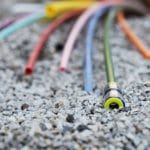
Bridging Digital Divide with Fiber
There are many resources that smaller, isolated, and rural communities are deprived of. Some are so-called “food deserts” where even grocery stores are hard to come by. Other communities are so far removed from densely populated areas that health care is sparse. One of the most commonly lacking resources, though, is access to the internet. Many isolated areas are entirely dependent on private internet service providers — or ISPs — that offer inconsistent or prohibitively expensive service. Implementing internet access is imperative to rural development, but it’s not always easy to do when there are already very few resources located in such areas. Fiber optics is the most viable way to provide municipal broadband to small, rural communities and bridge the digital divide.
Serving Students of Local Schools
One of the most important uses of municipal broadband is its ability to provide students of local schools with much-needed internet access. Internet is a vital resource for students because it provides them with the ability to do the following:
- Submit assigned homework and quizzes online
- Do research for projects and papers
- Download software such as word processing programs
A web connection gives students the power to perform academically and learn the basic research skills that school necessitates. It is estimated that over 9 million students do not have internet access at home, and this deficit leaves them at a substantial disadvantage over more privileged students who do. Fiber optic networks can help close this gap and ensure that students of all ages have access to the online resources they need to succeed.
Eliminating the Money Motive
It is important to note, too, that many students — and individuals in general — are excluded from internet access because of financial barriers. In areas where connectivity is limited, or a single internet service provider has a monopoly, prices can easily rise to the point that they are prohibitive. Most ISPs also charge fees in addition to the basic monthly service charge. Companies motivated to turn a profit make the internet inaccessible for countless people in rural areas. Municipal broadband eliminates the money motive that creates this problem. Instead, it creates an internet connection that is accessible and locally governed and exists for community improvement rather than corporate enrichment.
Ensuring Equitable Access
By eliminating the motive for money, municipal broadband connections have become a revolutionary resource for rural communities across the country. The most stunning impact of this initiative is its role in creating more equitable opportunities for individuals in such areas. By providing rural areas with access to the internet, fiber optic networks are also providing equitable access to all of the internet’s resources, including job opportunities, telehealth healthcare, educational opportunities, and other important information and news.
A major part of bridging the digital divide is ensuring that rural and isolated communities are not excluded from internet access. Fiber optic contractors are mitigating many social inequalities, too. Knowledge is power, and there is nothing more empowering than the ability to seek out knowledge readily with the click of a mouse. Equitable internet access is community empowerment.
Municipal Broadband for Stronger Communities
There’s no doubt about it — widespread internet access makes communities stronger, empowered, and more connected. The problem is, though, that too many rural areas lack web connections or rely on ISPs that implement financial barriers to access. Fiber optics offer the opportunity to combat this problem through the creation of municipal broadband networks. These networks contribute to rural development and strengthen the communities they are implemented in. We can bridge the digital divide with fiber optics.
V1 Fiber offers comprehensive fiber optics services, including the deployment of municipal broadband programs. You can reach out online or call us at (828) 299-0808 to learn more about our experience installing fiber optic networks in communities like yours.





No Comments
Sorry, the comment form is closed at this time.